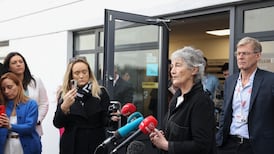SAIL number TS IRL 15: you caught a glimpse of the hull's distinct outline on the horizon, and your heart always missed several beats, writes Lorna Siggins
On a grey Galway afternoon several months ago, car were abandoned to clampers and commitments forgotten as we pelted down Nimmo's pier to watch Asgard IIapproach the docks.
"Quite exceptional" was how the brigantine's historians, Winkie Nixon and the late Capt Eric Healy, described the affection in which the ship was held here, matched only by the prestige it afforded the State overseas. In their book Asgard: The Story of Irish Sail Training, published eight years ago, they recorded how its creation by naval architect Jack Tyrrell during the gloomy economic period of the 1970s became synonymous with an emerging "new" Ireland.
Tyrrell spent many years trying to win support for the project, according to Nixon and Healy, who described how he displayed models of his design at successive boat shows. The late defence minister Paddy Donegan may be best remembered for his "thundering disgrace" remark which led to the resignation in 1976 of President Cearbhall Ó Dálaigh. Yet it was thanks to him that the brigantine was built at all.
Donegan was a keen sailor, and had received assistance at sea some years before from Capt Healy, then master of the original training ketch, Asgard. Two days after being appointed to Cabinet, he he saw Tyrrell's full plans for a purpose-built vessel in the sailing magazine Afloat,and promptly lifted the phone.
The benefits of the initiative were aptly described by former trainee Kevin McDonnell in a letter to this newspaper after the ship's sinking in the Bay of Biscay last month: "What the Asgard IItaught its sailors best was that only a classless society could exist on board."
RETIRED Russian submarine commander Sergey Aprelev can empathise with that. He recalls watching the Asgard IIsail up the Liffey and berth during the 1998 Tall Ships Race, when Colombia's Gloria, Argentina's Libertadand Mexico's mighty Cuauhtemochad transformed the quays into a mardi gras.
Aprelev had been on the first vessel to arrive, a Bermuda yawl called Okeah( "Ocean") from St Petersburg. It had missed the race start in Falmouth, had its sails blown out, and couldn't complete the course leg to Vigo in Spain in time. The 10 weary crew on board, including Aprelev and his 15-year-old son, were determined to get to Dublin after two long months at sea.
Not only did they receive a special prize for courage, but they were adopted by Dubliners, including members of the Poolbeg Yacht Club. "We had a 45-year-old engine from a London taxi, which we thought was impossible to repair," Aprelev recalls. "But someone knew someone who knew someone who had worked on those taxi engines before. . ."
Aprelev was chief mate then, relishing a life up top on deck after years spent beneath the sea's surface as a submarine commander during the Cold War. After seven years below on two vessels, he was seconded as adviser to the Algerian defence forces and became "grandfather to the Algerian submarine fleet in north Africa", he says.
Some insight into his experience of sunless existence below the waterline is conveyed in K-19: The Widowmaker, the 2002 Hollywood film which starred Liam Neeson and Harrison Ford. Part of the production was shot on the former Russian submarine B77, which had been sold off in the wake of perestroika.
Aprelev was technical adviser on the film, working closely with both Neeson and Ford. This new career path led him to found the St Petersburg International Maritime Film Festival, of which he is now director. Last year, thanks to his Irish friend, fellow sailor and journalist Tim Magennis, his jury received an Irish nomination - for the documentary on Northabout, the Irish yacht which made history with its polar circumnavigation through the North-East and North-West passages.
"Even though it was critical of Russian bureaucracy, we gave it an award," Aprelev says. "We need such films," he laughs.
This year there was another Irish success at the festival. Eamon and Cian de Buitléar's Islandmanwon the "man and the sail category" for its portrayal of the late Galway hooker skipper Johnny Bailey.
Aprelev, who travelled to Dublin recently to present that award, is looking forward to receiving more Irish nominations for the festival - and what better subject than Asgard II, and the Irish sail training programme's future?
WHATEVER happens to the vessel - currently described as in good condition on the seabed, but unlikely to remain so as winter closes in - there is plenty of experience and expertise ready to build a replacement, as Minister for Defence Willie O'Dea has been reminded.
Down in west Cork, for instance, big boat skills are due to be developed at a five-day workshop led by Gary McMahon of the AK Ilen company. McMahon has been closely involved over a number of years in restoring the ketch Ilen, which was commissioned by Conor O'Brien, the first Irishman to sail around the world. It was built in Baltimore's fisheries school in 1926 for the Falkland Islands Company and experienced some of the best and worst of the south Atlantic before being returned to Ireland in 1998. McMahon believes it represents the "perfect expression" of an Irish sailing vessel.
His workshop, which will be based in Hegarty's Boat Yard in Oldcourt, near Baltimore, starts with an introduction to wooden boat construction by shipwright Liam Hegarty, followed by a talk on native Irish oak by Brother Anthony Keane, forester at Glenstal Abbey, Co Limerick.
Sleeves will then be rolled up for the practical repair work on Ilen, which will include replacing oak frames, bevel cutting, planing, sanding, painting, heaving, hauling, cursing, sweating. . . and laughing in between. For more details, contact Gary McMahon on 086- 2640479. The full programme is on the website www.bigboatbuild.com.










